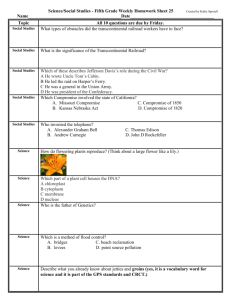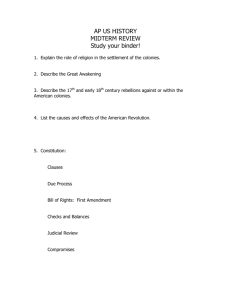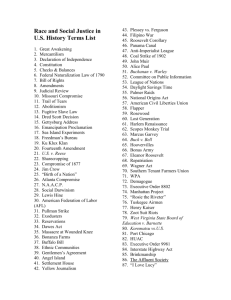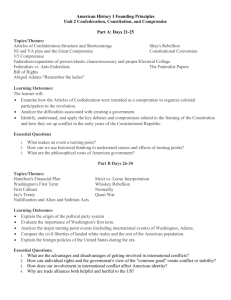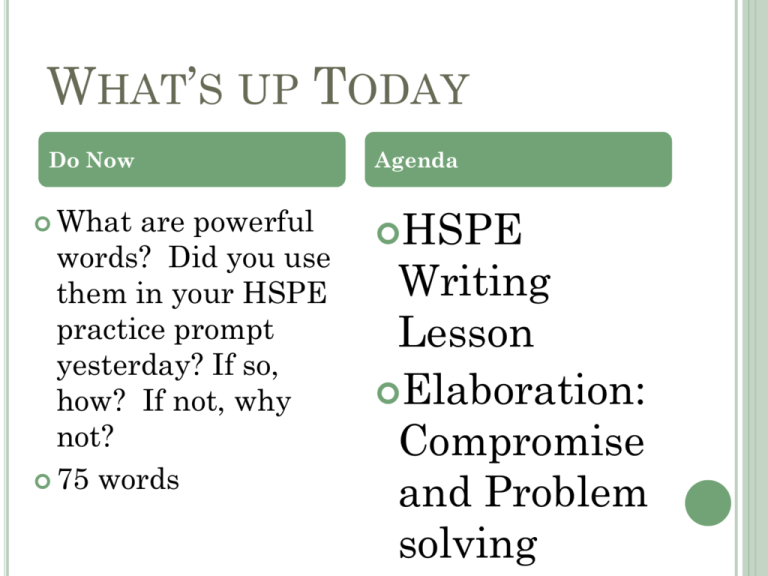
WHAT’S UP TODAY
Do Now
What
are powerful
words? Did you use
them in your HSPE
practice prompt
yesterday? If so,
how? If not, why
not?
75 words
Agenda
HSPE
Writing
Lesson
Elaboration:
Compromise
and Problem
solving
PERSUASIVE WRITING
Elaboration Techniques:
Compromise & Problem Solving
Statistics
COMPROMISE
&
PROBLEM SOLVING
COMPROMISE & PROBLEM SOLVING
What does this mean?
A compromise is when people try to find a
solution to their disagreement that both people find
acceptable. Usually both parties have to give in a
little on what they want in order to reach an
agreement.
When you problem-solve in your writing, you
explain a problem or an issue, then offer a solution
to the reader.
Both types of Elaboration/Argumentation take the
other person’s perspective into consideration.
What Might These Look Like?
Topic: proposal for an 8:00 p.m. curfew in your town for students under
17 years of age.
If kids want to spend time with
their friends after the hours listed
by a town’s curfew, then they can
just arrange a sleepover for the
night. This way kids are off the
streets, and safe, but they can still
be with their friends as long as
they want.
Compromise
Since officials in town are
insisting on imposing a curfew,
they should consider changing
the time to allow kids a little
more freedom. A curfew of 10
o’clock would be much more
bearable for most teenagers.
What Might These Look Like?
Topic: your high school is looking for ways to improve the student
passing rates.
I understand that the teachers at
our school want to find a way for
students to be successful. The best
way for students to do better is to
give them a specific enrichment
class every day where they can get
more specific help in the subject
area where they are struggling.
Problem
Solving
For students who are struggling in
school, our teachers should offer
lunch help a few days a week to
tutor students one-on-one. This
way kids get personalized help, and
the kids who really want to get
better will show up and really use
the time well.
Problem Solving:
Great Transitions!
The real problem is…
A possible remedy…
The underlying issue is…
The best solution…
The specific problem is…
A better way…
We have to acknowledge…
The proposed solution…
Many people are aware…
To correct this issue…
Copyright © 2007 Washington Office of Superintendent of Public Instruction. All rights reserved. Modified 11/08
Problem Solving Identification:
Can You Find Examples?
Underline the examples of PS and circle the transitions you find.
Since the world dumps tons of garbage and waste onto the
planet every day, recycling should become the law. The real
problem is that every week, each family of four generates
enough trash to fill two 32 gallon garbage cans. This happens
because people are lazy, have busy lives, and buy products with
excessive packaging. If people knew there was an immediate
consequence for this waste, they would be more inclined to
recycle. We must acknowledge that no one likes to pay a fine or
have the government tell them what to do, but if recycling were
required, we could reduce the amount of trash produced by at
least 50%. The best solution to curbing pollution is to enforce
recycling by law.
Copyright © 2007 Washington Office of Superintendent of Public Instruction. All rights reserved. Modified 11/08
Compromise Identification:
Can You Find Examples?
Underline the examples of compromise that you find in the selection.
I believe that there are more effective ways to get the message
across that the current behavior is unacceptable than to tether
kids to chairs for the ½ hour they eat lunch. Just because some
students are noisy, disruptive, and disorderly doesn’t mean that
all the students are. It is unfair to punish those who are being
perfectly well behaved. We could institute lunch detention,
where disruptive students eat in a classroom, unable to talk
with friends. This could be the consequence of the “three strikes
you’re out” rule where if a student is caught with unacceptable
behavior three times, consequences are then dealt. There are
more practical ways to deal with disorderly kids than with
assigned seating at lunchtime.
Copyright © 2007 Washington Office of Superintendent of Public Instruction. All rights reserved. Modified 11/08
Let’s Try it Together!
Topic: You’re writing a letter to your parents to adjust a punishment.
Last weekend you decided that I am
grounded until after Christmas
because of my grades, since you want
me to spend more time working on
homework instead of out with friends.
Compromise
While I understand completely that I
need to work harder in school… (now
you finish this sentence – do you have a
compromise? What can you give in return
for what they want?)
(so…now write a follow-up sentence.
How does this compromise give both of
you what you want? How is it equally
satisfactory? )
Try It With a Partner!
Topic: Your school wants to keep students inside at lunch time due to the
garbage and the graffiti that has been found lately.
On yesterday’s announcement the
councilor told the student body that
we will no longer be allowed outside
during lunch because of the littering
and graffiti issues at our school.
Problem
Solving
However, I think that the real
problem is … (hmmm. How could you
explain the problem so that not everyone
is blamed and punished?)
Notice the underlined
words – those are the
transitions that were
listed in an earlier
slide. Use these as
sentence starters.
To correct this issue… (what is your
solution? How could you fix the problem
without keeping all the students inside at
lunch?)
YOUR TURN!
WRITE YOUR OWN “COMPROMISE”
Consider Friday’s practice write about
making Timberline a closed campus.
Provide an example (2-4 sentences) where
you could use either a compromise or a small
problem solving argument for the position
that you took. Complete in you Interactive
Notebook.
Write!
5 minutes
YOUR TURN!
WRITE YOUR OWN “COMPROMISE”
Consider Friday’s practice write about
making Timberline a closed campus.
Provide an example (2-4 sentences) where
you could use either a compromise or a small
problem solving argument for the position
that you took. Complete in you Interactive
Notebook.
Write!
Share your examples with a partner.
Discuss how you strengthened your argument
by using compromise or problem solving.
DO NOW
What are compromise
and problem solving
in essays? How do
you use them.
75 words
STATISTICS
AS
ELABORATION
WHY DO I USE STATISTICS TO PERSUADE?
The use of statistics as a form of elaboration is a
solid writing technique that will most often be used
in persuasive writing or analytical essays. Statistics
are great because they…
give hard evidence that what you’re trying to
prove is true
show that there is serious research that supports
what you’re trying to prove
make you sound like a professional and an
expert
NOTE: THERE ARE RULES!
When writing a real essay for your classes in school,
essays that are requiring you to do research and to
give factual support to your ideas,
DO NOT MAKE UP YOUR STATISTICS !!!!!!
You can get in a lot of trouble for this and will
probably (definitely) fail the assignment.
If you take your facts, numbers, or statistics from
another source, remember to use a citation to show
where you got your information.
… AND EXCEPTIONS, TOO!
However, for HSPE purposes, or for any type of
On- Demand Write, it is perfectly acceptable to make
up the statistics to use. Why is this okay for these types
of papers?
with an on-demand write, you have no access to
computers or research to find real statistics
using a made-up statistic shows you know the power of
facts in an essay; you know your “writing
toolbox” and how to use it!
using a made-up statistic shows that you know how to
use facts to support your ideas, but you just can’t get
any at the moment because you’re locked into your
desk
WHAT MIGHT THIS LOOK LIKE?
While our school does a great job
with having Honor Level
Activities, we need more dances
at night. When students were
polled about evening dances, 96%
agreed they would like to have
them more often.
These are
made up
statistics!
In the potential/kinetic
experiment, two model cars were
sent down slopes of different
heights. The race was conducted
ten times, and 90% of the time
the car from the steeper slope
moved the farthest & fastest.
IN A PAPER FOR A CLASS…
Since the Constitutional Convention
was so soon after the Revolutionary
War, many people were afraid of the
federal government having too much
power. Initially 63% of delegates
were against the idea of having a
central government in the United
States (www.histstats.com).
Note that I
included citations
in these examples.
Kick-boxing is a great way to tone
muscles and lose weight, while still
having fun. Recent studies show
that the average female burns 650
calories for a 45 minute session,
which is 40% more than jogging
the mile in P.E. (Time, Feb. 2006).
FORMATTING IS IMPORTANT!
When you use a statistic in an paragraph, keep in
mind three important parts:
Make sure you’ve chosen a strong statistic
Reference the source of the statistic (can be a citation)
Use a summarizing phrase or sentence that explains
the significance of the statistic
Let’s Try it Together!
Topic: Offering a wider variety of lunch choices in school.
A definite improvement to our
lunchroom would be to have a small
Taco Bell stand set up in one corner
of the cafeteria.
(now write a sentence that
includes a statistic to support
the idea that Taco Bell needs to
be added to the lunchroom)
(so…now write a follow-up
sentence. How does this statistic
help build your argument?)
Try It With a Partner!
Topic: Your district is asking people to give input on school start times.
Starting school time later would be
really helpful for most teenagers
because it would give them more time
in the morning to get the sleep that
their bodies need.
(this time insert a statistic like one you
might find in a magazine or online.
Include a “citation” at the end of the
sentence)
(again, write a follow-up sentence.
What significance does your statistic
have? How might it sway your reader?)
Culminating Persuasion Activity:
OR
How Good Are You Now?
You have now learned six different persuasive writing elaboration strategies. At
this point you should be AMAZING at persuading your audience! Today we’ll test
that theory… Your Task:
Groups:
What:
3-4 students
create a short skit that uses at least four of the
persuasive strategies in order to meet the goal stated on
the topic card you will receive.
Format:
write a script that shows interaction between the two or three people named on
the topic card – make sure your persuasive strategies are strong!
Highlight the strategies (& make a key!) as they appear in the script.
During the performance, one person in the group will silently hold up strategy
cards to show when each chosen strategy is being used.
A special thanks to Sarah Corneil & Heather Hettinger for their help with this one!
YOUR TURN!
USE YOUR OWN STATISTICS
Go back once again to the paper that you
wrote about winning the trip to the Great
Wolf Lodge.
Re-read the paper and find a place or two
where you might be able to add a strong
statistic.
Write!
Share your changes with a partner. Discuss
how you just strengthened your argument.

